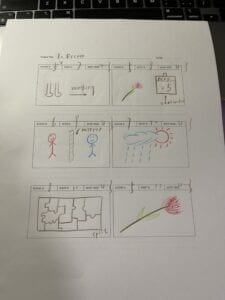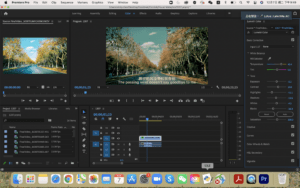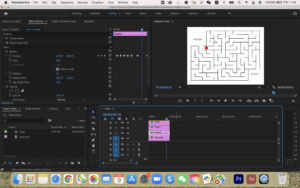Topic: To Dream
Team Member: Yijing Ling
1. Concept & Story
Our visual metaphor project is called ” To Dream.” The story is about a girl chasing her dream. After farewelling to the past, experiencing solitude, being misunderstood by others, encountering obstacles, the girl is still willing to keep running to fulfill her dream even though she usually covers her goals by telling jokes. We are inspired to create this project because we are now freshmen, just on the way to finding a major and planning for the future path. Also, I feel a little anxious and depressed this semester because I think I am not talented enough and feel frustrating about choosing the major that I really like and also have the ability to handle it. Therefore, we hope we can encourage ourselves to never give up on the way of chasing dreams by making this short film. We started to think if there are similar words in books, videos, broadcasts, and so on. We wanted to use a quote that at least one of us is familiar with so that we can interpret it well. After the Thanksgiving Holiday, we put forward many different sentences and decided to choose a voice-over of a Douyin video by Wan, Zilin in the end. The reason why we want to explore this topic is that even though there are many short videos about dreams, we have not tried it before, not to mental using metaphor for the whole video. As a result, it seems interesting and meaningful for the communication lab final project.
2. Creation Process & Execution



We have changed many editions in the visual metaphor project that we did not have time to draw storyboard again and again. We wrote down the scene description beside the voice-over to help us understand more clearly what is needed to film and how to record. In addition, we discussed a lot about the setting and shooting because sometimes the results are different from our imagination. For instance, it is very difficult to fly a kite, so we talked a lot about changing the screen, such as filming the ballon, or not. Besides, I also faced some challenges during the creation process. For example, I felt embarrassed and awkward to ask for others’ help. Hence, I always hesitate to choose who can I ask when I need actors or helpers. To solve the problem, I chose to treat them to meals or drinks to show my gratitude. I learned some editing technologies as well. For example, I become more familiar with the color panel.
 Nevertheless, sometimes it is hard to change the color tone for some special parts of the scene because there are differences due to the light change on the object. What is more, I use Illustrator and Premiere to create a maze with a small red ball rolling inside.
Nevertheless, sometimes it is hard to change the color tone for some special parts of the scene because there are differences due to the light change on the object. What is more, I use Illustrator and Premiere to create a maze with a small red ball rolling inside.

3. Collaboration
For the voice-over stage, my work is finding suitable sentences in movies, books, or mv. For the filming stage, we divided the whole shooting task. Yijing mainly focused on small inside objects, and what I need to film is more like outside scenes such as the kite, Nanjing East Road, people on streets, and so on. For the editing stage, I pay more attention to the edition after critique in class, such as repositioning videos and audios, changing speed, and adjusting color for some scenes. Thanks to Yijing that she filmed many objects that are hard for me to get. For example, the glass, the flower, and puzzles. Furthermore, she recorded the voice-over well, which contributes to our project a lot. We have different opinions about the scenes from time to time, such as the color tone. We persuaded each other and make a compromise plan that can fit both aesthetics. In the process of discussion, I have learned some transition effects from Yijing, which I am not familiar with before. Furthermore, she encouraged me to refilm unqualified videos, such as the kite part.
4. Aesthetics & Results
We both agree that the video we wanted to film has two parts and one transition sentence. For the first part, the emotion is more depressed and dull, while the second part is relatively bright and inspiring. Therefore, we adjusted some scene colors to better fit the feelings we want to deliver. Speed is also a factor that we spend a lot of time on. At the beginning of the video, the pace is slow. At the end of the first part, the speed increases to adapt to the coming motivating music. For the second part, the speed slowed down a little since the voice-over is about past obstacles and determination. Finally, we filmed the same settings with different camera angles so that we can choose which one is more suitable. For example, in the first part, we mainly use long camera shot to represent the dull emotion.
Leave a Reply